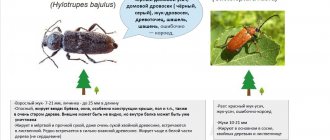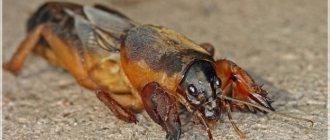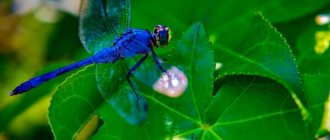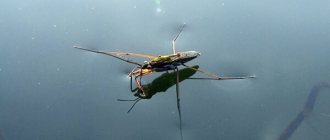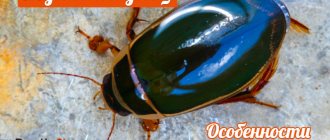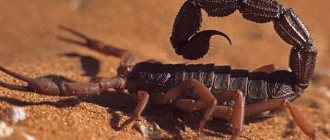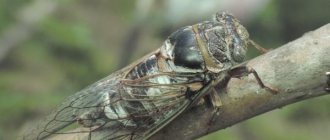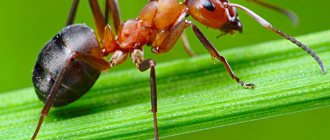- Medvedka: description, structure, characteristics. What does a bear look like?
Medvedka, the name of this insect is well known to all gardeners, summer residents, gardeners, and those who grow plants, and it is familiar in a negative aspect. After all, the mole cricket (aka cabbage mole cricket, aka mole cricket) is a pest for many plants. What are the habits of this insect, what does it look like and how to fight it, read about all this further in our article.
Where did the name “Medvedka” come from?
Mole crickets got their name because of their appearance, large size, brown-brown color and clawed front paws. All this gave reason to compare this insect with the brown
bear
The mole cricket’s second name, “cabbage mole cricket,” comes from its love for young cabbage seedlings. But the third name “mole cricket” comes from the Latin “Gryllotalpa” (properly translated as “mole cricket”) and it is also not accidental. Medvedka is similar to
It is similar to a cricket in its body structure and ability to make sounds, and it is similar to a mole in its ability to burrow into the ground and its extended hands of the front paws, which help dig the ground.
Why is the mole cricket called that?
The insect got its name due to its brown color and dark brown small hairs covering the body, large size and sharp black claws, which are located on the front legs. It looks quite scary. Other nicknames include the following:
- Kapustyanka - this name was given to her because she loves to eat the leaves of young cabbage heads, potato tubers and beets.
- Mole cricket - for its resemblance to an insect from the same family of jumping Orthoptera, which can make sounds by rubbing its elytra, and to an animal that digs its own holes and has strong front legs.
- Earthen crayfish - for its hard chitinous shell and claw-like paws.
And also, sometimes, you can hear the nickname “top” - this is because young individuals have a gray color and pointed spines on their limbs.
Description, structure, characteristics
Mole crickets are arthropod insects and are quite large (for insects) in size. The body length of the mole cricket is from 3.5 to 5 cm. Its body is brownish-brown on top and brownish-yellow below. The body of the mole cricket is covered with thin hairs.
Visual structure of a mole cricket.
The insect's head has a direct or prognathic location in relation to the body. The axis of the body coincides with the axis of the head. The mouthparts are powerful and forward-directed jaws, and next to them are two pairs of tentacles.
The mole cricket's eyes are quite large and clearly visible; they have a facet structure and are located on the sides of the head. On the head itself there are small thread-like antennae.
The pronotum of the mole cricket with the side parts (blades) that hang down is large and flat, it is a distinctive feature of this insect. The head and front part of the body of this creature are covered with a dense chitinous shell, with its help the mole cricket can push and compact the earth when digging holes. Thanks to him, she is somewhat reminiscent of a crayfish.
The abdomen of the mole cricket is thick, it has 1 cm in diameter, and on its top there are anal and genital plates.
The mole cricket has two pairs of wings:
An interesting fact: it is by the venation of the mole cricket's wing elytra that one can distinguish males from females. The larvae of this insect do not have wings.
The mole cricket also has three pairs of limbs, and each of them consists of a coxa, trochanter, femur, tibia and a 3-segmented tarsus. The hind legs are strong, as they are designed for movement and have 1-4 spines on their inner side. The forelimbs, somewhat reminiscent of claws, are essentially a digging apparatus.
Interesting fact: the mole cricket's hearing aid is located on the shins of the forelimbs, just like in grasshoppers, crickets and some other chirping insects.
Medvedka: description and damage caused
Mole crickets are large burrowing insects that form a separate family. They are 5-9 cm long and live in burrows they dig. The appearance of the pest is very characteristic; it is difficult to confuse it with any other insect.
Medvedka
The fight against mole crickets on the site is, first of all, a strategic fight. Leading a secretive lifestyle, the insect always finds options on how to survive in the conditions of certain countermeasures, therefore, in order to defeat this pest, just one method of exterminating it is not enough; it is necessary to use several.
The insect's forelimbs are seriously modified and adapted for digging. The chest shell is thick and very durable. In case of danger, the insect's head is completely retracted under it.
The abdomen is long, approximately 2-3 times larger than the cephalothorax, however, it is practically not protected by a chitinous layer. The body color of a mole cricket is almost always the same – it is dark brown on top and light brown or olive underneath.
A mole cricket protecting its clutch
The insect is a pest of many crops. All tuberous, root, berry and fruit crops are included in the list of the mole cricket’s diet. If there are no root crops, the pest moves on to rhizomes and bulbs.
In particularly serious cases, it even damages the root system of not only fruit trees, but also non-fruit trees.
Mole cricket larva
Signs of the appearance of a mole cricket on the site are its passages, burrows and loud evening chirping, reminiscent of the sounds made by crickets. Which, however, is not surprising, the families of Medvedkov and Real Crickets are very close relatives.
Mole cricket moves after precipitation
What sounds does a bear make?
The mole cricket, like the cricket, is a “musical” insect, capable of producing chirping trills that can sometimes be heard at a distance of up to half a kilometer. Sounds are made by
friction of rigid front elytra against each other.
The trills of mole crickets serve communication between them, as well as a very important matter - sexual reproduction of insects, since through the performance of “love serenades” males attract females. Females, by the way, are also capable of chirping. The sound power of the mole cricket is 1.4 mW, while for the cricket this figure is only 0.06 mW.
Nutrition
All summer residents know that the mole cricket is the most common pest of vegetable, fruit, berry and garden crops. They damage roots, tubers, seeds, underground parts of plants, and sometimes eat young plants. Mole crickets spoil potatoes, corn, beets, cabbage, tomatoes, cucumbers, eggplants, peppers, turnips, pumpkins, watermelons, melons, grapes and many other crops. In the south, exotic citrus fruits (oranges, tangerines, lemons), peanuts, cotton, and tea also suffer from them. In forests, mole crickets damage the roots of many trees: oaks, beech trees, pine trees, etc.
But do not think that mole crickets are exclusively vegetarians (however, very harmful vegetarians), being omnivores, they also eat some living creatures: earthworms,
ladybugs, dragonflies, beetles and some other smaller insects.
Food preferences
What the mole cricket eats is of interest to gardeners, gardeners, and lovers of flora and fauna. The mole cricket insect is a predator that prefers plant foods.
The mole cricket eats the soil's contents. It feeds on roots, roots, and the green part of plants that are located directly above the soil. Finds food in the depths of the earth - small insects, larvae, earthworms. A delicacy is the pupa of other insects, caterpillars, and butterflies.
Interesting!
Its feeding characteristics make the mole cricket both a useful and harmful creature. In the forest, the insect brings great benefits - it loosens the soil, saturates it with oxygen, and destroys pests. In the garden, in the garden, they are trying to get rid of mole crickets with all their might. In garden beds, it chews through green stems, destroys the root system, and gnaws root crops. Does not allow seedlings to take root or seeds to germinate.
Habitats
These insects live over a wide geographic range, almost everywhere in Eurasia (with the exception of the northern Scandinavian countries), North Africa, the Americas, and Australia. They are not found only in
Antarctica northern arctic regions.
As a habitat, mole crickets most like wet places: meadows, floodplains. They usually live in underground passages and are often found near irrigation canals and in wetlands.
Is it dangerous for humans?
Seeing a mole cricket, everyone will be afraid of how unattractive she is. But the pest is not poisonous and does not pose a danger to humans. Some gardeners claim that these insects bite. But even adults can only pinch lightly with their front paws. Sometimes the bite is painful, but this sensation quickly passes without a trace.
Although the mole cricket is not poisonous, it does a lot of harm due to its lifestyle. This insect is dangerous to plants and crops. But there are many ways to get rid of it, and any gardener will always choose the one that is suitable in each individual case. And if events are held in a complex, and even together with neighbors, the pest is forgotten forever.
Lifestyle
These insects prefer to lead a secretive and nocturnal lifestyle, hiding in their burrows during the day and going out to hunt at night. Their presence in a garden plot can be determined by winding, loosened ridges of earth, small holes in the ground, and, of course, by healthy plants that suddenly begin to die for no reason at all.
This is what mole cricket tunnels look like.
It is at night that mole crickets spoil/eat plants; they are also able to fly over considerable distances in search of food (usually they are attracted to bright light). They are also capable of not only flying, but also swimming.
Prevention of occurrence
A typical insect light trap used to control mole crickets
To protect the area from the appearance of unwanted guests in the form of mole crickets, a number of measures should be taken. Most of them are in the nature of general recommendations carried out when counteracting various pests.
Such measures include:
1 Planting the repellent plants described earlier on the site
2 Digging of areas along the perimeter with furrows with naphthalene or special means Medvetsid
3 Systematic inspection of all types of soil and fertilizers brought to the site (manure, humus, black soil, sand, etc.) to search for mole crickets, their eggs and larvae. Approximately a third of the cases of pest penetration into plots occur with imported soil material
4 Regular weeding and loosening of the soil. Weed removal
5 During the mole cricket’s flight (mid-to-late May), use specialized light traps that are suspended above containers (you can use a regular basin) with a water-kerosene composition. Insects, flying towards the light, stumble upon a trap and fall into a basin, where a layer of kerosene located above the water envelops their bodies, causing suffocation and death
6 Since the mole cricket lives exclusively in acidic soils, it is recommended to carry out annual deacidification of the site by adding dolomite flour or lime to the soil.
At the same time, it must be said right away that some methods of preventing the appearance of pests are not applicable to mole crickets. For example, burying metal mesh around the perimeter of the site, which is very effective against moles, will not have any effect on mole crickets.
Firstly, mole crickets are somewhat smaller than moles, and secondly, unlike moles, they can move both on the ground and in the air.
Natural enemies
Of course, the mole cricket has its own enemies in natural conditions, among them rooks, starlings, crows,
hedgehogs, lizards, moles, ants (they pose a threat to mole cricket larvae). Also among pets, the enemy of this insect harmful to the garden is the cat, which can hunt and eat mole crickets like mice and rats, which is of great benefit to the household.
Types, photos and names
Different types of mole crickets practically do not differ from each other, neither in appearance, nor in habits and way of life. They can be distinguished biologically only by the number
chromosomes. Next, we will describe in detail some common types of mole crickets.
Mole cricket
In fact, this is the most common species among these insects. Widely distributed in Europe (with the exception of Scandinavia), lives in a number of Asian countries and northern Africa. Almost everything that we describe here about mole crickets, first of all, concerns the common mole cricket.
African mole cricket
It is slightly smaller in size than the common mole cricket, the body length is 2.5-3.5 cm. It has a brown-yellow body color. Lives in the African tropics and subtropics, but in addition to the “Black
continent" is also found in Southeast Asia and even on the Japanese islands.
Ten-toed mole cricket
This species is distinguished by its small size - from 1.9 to 3 cm. It inhabits both Americas, and it is believed that initially they were found only in North America, but gradually penetrated into South America.
Steppe mole cricket
In appearance it is an exact double of the common mole cricket. This species prefers steppe terrain as a habitat; it lives in the steppe belt of our country, Ukraine, southern Russia, Kazakhstan, Turkmenistan and a number of other Middle Eastern countries.
Biological methods
The mole cricket has many natural enemies. First of all, these are birds. The greatest damage to the population is caused by rooks, crows, starlings and even ordinary chickens.
Hoopoe catching a mole cricket
It is recommended to let the latter out into the garden from time to time. Naturally, this needs to be done at a time when the chickens themselves cannot harm the crops; for example, before the beginning of periods of active growth of young plants, fruiting, harvesting, etc. Chickens are able to perfectly find mole crickets and their larvae and destroy them.
In addition, hedgehogs, lizards, shrews, moles and ants are involved in the destruction of mole crickets. Attracting, for example, a hedgehog to your garden is very simple - just place a saucer of milk in the garden every evening.
With birds, everything is also relatively simple - birdhouses or nest boxes on the site will significantly improve the situation with any harmful insects, including mole crickets.
There is also a highly specialized enemy of the mole cricket – the Larra anathema wasp. This type of wasp lays eggs exclusively in mole crickets, where their development occurs. After the larva matures, it leaves the host, who soon dies.
Larra anathema wasp, a natural enemy of the mole cricket
This insect does not pose any harm to humans, plants and other inhabitants of the garden, therefore, if you encounter this wasp, there is no need to destroy it. The wasp is quite widespread in the south of the European part of Russia, in the Krasnodar Territory, as well as in Ukraine, Moldova, and Georgia.
If the issue of counteracting mole crickets is very pressing, you can also try to use wasps to combat them. Legumes are used to attract wasps. larra” is best attracted to a plant called “partridge pea”.
Reproduction
The mating season for mole crickets begins in the spring, after their mass exodus from the burrows in which they spent the winter. Moreover, the mating process itself takes place underground, in burrows. In summer, offspring appear.
Both female and male mole crickets carefully prepare for the birth of future children; they dig complex and branched underground labyrinths and, at a shallow depth (about 5 cm from the surface), create spherical nests 10 cm in diameter. The female mole cricket lays from 300 to 600 eggs in these nesting sites. All this time, the female does not leave her eggs, maintaining the desired temperature and providing ventilation; for this purpose, she continually clears the passages, eats up the roots of plants that cast a shadow on the eggs, etc. All this is critical for the survival of the offspring. The mole cricket eggs themselves are somewhat reminiscent of millet grains; they are oval in shape, yellowish-gray in color and no more than 2 mm in size.
After 10-20 days, the mole cricket eggs begin to hatch into larvae, also known as nymphs, which are small gray six-legged wingless creatures. Otherwise they look similar to adults. For the first 20-30 days, the larvae are under the close protection of the mother, and at the end of this period, the female mole cricket, which gave birth to abundant offspring, unfortunately dies. At this time, the larvae are already crawling into burrows, starting to dig their own holes and look for food. Their development and transformation into a full-fledged adult takes from 1 to 2.5 years.
Behavior
The mole cricket spends most of its life underground. There it digs passages, builds labyrinths, and builds nests. It comes to the surface at dusk in warm weather. Looks for food or rises into the air to search for a male.
The body structure of the mole cricket allows it to swim on the surface of the water. She calmly overcomes a large puddle and escapes the flood. But if water gets into the burrow, the insect dies.
The heat-loving insect successfully survives winter frosts through half the soil. With the onset of heat it gradually rises to the surface. The presence of the pest in garden plots can be noticed as early as April. Paths form in the ground, footprints are visible, and plants die.
On a note!
The mole cricket is a timid creature that hides in a hole at the slightest rustle. It is impossible to catch her with your own hands. But, if you build a trap, you can significantly reduce the number of insects on the site.
How to deal with a mole cricket
The fight between this insect pest and the gardener has been going on since ancient times; the arsenal of the fight against mole crickets includes both time-tested folk remedies and modern means of disinfestation. We will look at this in more detail later.
Chemicals
You can make bait for it from steamed grains of corn, oats, barley, wheat or rye, not forgetting to add poison there. Previously, such strong agents as zinc phosphide and dust (DDT) were added to such baits. Now, for this purpose, much safer special poisons are used exclusively for mole crickets, for example, Medvetoks, they do not harm the soil or earthworms, but only kill pests.
Ready-made bait can be purchased at a specialized store. It is optimal to apply it to the soil in early spring, a week before sowing crops.
Agrotechnical measures
Agrotechnical measures, such as deep spring and autumn plowing, regular loosening of the soil, also help get rid of mole crickets in the garden or garden plot.
Destruction by mechanical means
You can try to fight with the mole cricket and various mechanical means.
- Set up traps for them in manure pits. The fact is that they like to spend the winter in manure. And when they gather in the manure pit in winter, it should be scattered around the garden. The mole crickets located there will die from the cold. True, this is only relevant for places with cold climates.
- In a place where mole crickets accumulate, dig a jar or bottle into the ground. Then pour beer in there as bait. Once they get there, the mole crickets will no longer be able to get out.
- Set up light traps for mole crickets - place garden lanterns, and under them containers filled with water and kerosene. Since mole crickets fly towards the light at night, when they hit the lamp, they will fall into the liquid prepared for them.
- You can pour water and sunflower oil into the holes made by pests. Water will push them to the surface, and oil will not allow them to breathe.
Fighting with folk remedies
- – You can try to scare away the mole crickets with unpleasant odors. These come from: rotten fish, onion skins, wormwood, garlic cloves and mint.
- You can also water the soil with diluted bird droppings. Chicken will also work.
- Plant plants that the mole cricket cannot tolerate: garlic, chrysanthemums, perennial cloves.
Precautions in the garden
When using strong chemicals against mole crickets, you must remember to be careful. Instead, other plants, soil or pets should not be harmed.
Where do mole crickets spend the winter?
Burrows dug in the ground or in manure help insects survive frosts. Adults dig deeper holes in the cold season than in summer. Approximately up to 1 meter, and they do them not strictly vertically, but at a certain angle.
The larvae also descend into the soil for the winter, but they go deeper to a much shorter distance, somewhere around 20-30 cm.
With the onset of spring, the mole cricket comes to the surface, but not before the soil temperature rises to 15 degrees.
Interesting Facts
- Gourmets in South-East Asia sometimes consume these insects as a delicacy. Moreover, they are prepared fried, stewed, pickled, with the addition of seasonings or even without them.
- Sometimes the mole cricket brings some benefit, as it destroys the larvae of cockchafers and some other insects that eat plants
- Surprisingly enough, there are benefits from Medvedka in the field of pharmaceuticals as well. So a powder is made from it, which is used as one of the components for a cure for tuberculosis.
Video
And finally, a short practical video on how to deal with mole crickets.
Author: Pavel Chaika, editor-in-chief of Poznavaika magazine
When writing the article, I tried to make it as interesting, useful and high-quality as possible. I would be grateful for any feedback and constructive criticism in the form of comments on the article. You can also write your wish/question/suggestion to my email [email protected] or Facebook, with respect, the author.
Author page
